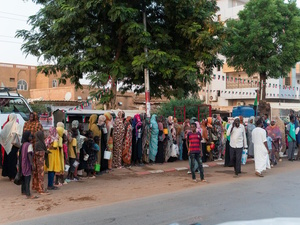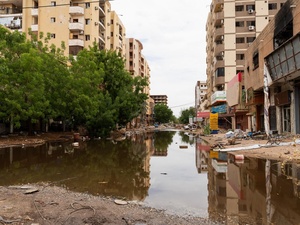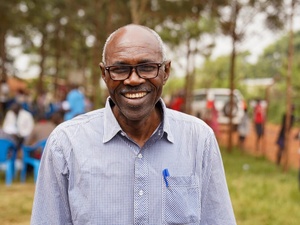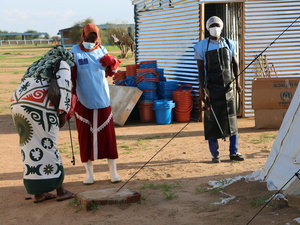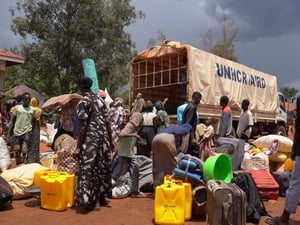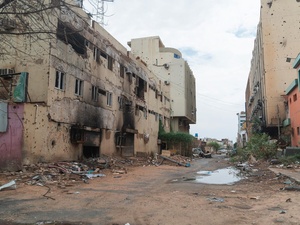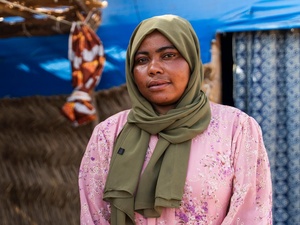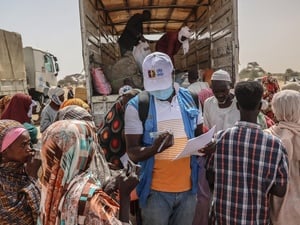Sudanese refugees struggle to cope at new settlements in Uganda
Sudanese refugees struggle to cope at new settlements in Uganda

Adul Santa (left) and her children at the transit centre in Ikafe settlement just before moving to her own plot of land.
IKAFE SETTLEMENT, Uganda, Oct 2 (UNHCR) - Adul Santa, a 33-year-old Sudanese widow with four children, is tired of life on the run. Driven from her own country by the 20-year-long civil war, she fled to Uganda last year, arriving at the Achol-Pii refugee settlement in northern Uganda shortly before it was overrun by the Lord's Resistance Army in August last year.
That brutal attack displaced Santa and her family, along with 24,000 other Sudanese refugees, who continue to be buffeted by military and political events beyond their control. Early in September, roughly a year after some 15,000 of those refugees crowded into Kiryandongo settlement, the Ugandan government uprooted them and moved them to two still-underdeveloped settlements in northern Uganda.
Standing amidst her meagre possessions in the transit camp at Ikafe, one of the new settlements, Santa says wearily, "We are very tired of moving from place to place." But she shrugs helplessly, "What are we going to do? We are innocent. We will go wherever you tell us to go, whether we are happy about it or not."
Santa hopes that in Ikafe, where she has been allocated one small plot of land to live on and another larger plot for farming, she can finally offer some stability to her children, who range in age from six to 15, until peace comes to Sudan and she can take them home.
It's a hope shared by the UN refugee agency, after the transfer from Kiryandongo by the Ugandan government left UNHCR and its partners struggling to cope with the thousands of refugees dumped in the mud at Madi Okollo and Ikafe settlements.
UNHCR had facilities in place to handle up to 900 refugees at a time in phased movements, but was overwhelmed by the arrival of more than 7,000 at each site. In addition, the agency had no money to construct in advance the roads, boreholes, schools and health centres needed to adequately take care of the new arrivals.
"We have to put (the transfer from) Kiryandongo behind us," says Juan Castro-Magluff, Acting UNHCR Representative in Kampala. "The relocation is now complete and we have to find the best way to go forward."
And that will cost money that the cash-strapped refugee agency is struggling to raise. Of $965,000 that UNHCR had budgeted for a negotiated, phased relocation, only $285,000 has been pledged - a donation from the United States. The situation is bleak, says Castro-Magluff: "We have no money to go forward right now."
Last week, representatives of donor countries went to Madi Okollo and Ikafe to see for themselves the needs of the refugees. It was a mixed picture. On some plots, after just a few short weeks, refugees have already planted cowpeas that they brought with them. Green shoots offer promise that the refugees can harvest their small crops by the end of October. Within a few years, all the newly-relocated refugees should be able to raise much of their food themselves.
But in Ikafe, allocation of plots had been held up by conflicting orders from the Ugandan government on how the plots should be demarcated - confusion that was resolved in one swift command by Moses Ali, Uganda's First Deputy Prime Minister and Minister of Disaster Preparedness and Refugees, who accompanied the donors.
"We are living under a tree, we are suffering," one 25-year-old Sudanese refugee woman with a sick infant said of the wait to be allocated a plot.
Although UNHCR, the World Food Programme (WFP) and their partners responded quickly to the emergency and distributed food, emergency plastic sheeting, blankets and other household necessities, refugees complain that not all their needs have been met.
"We really need mosquito nets. There are lots of mosquitoes and the children are getting sick from malaria," said a refugee woman with a baby on her hip. She and her family are camped out under temporary plastic sheeting in a hastily-cleared piece of land surrounded by long grass, shrubs, trees and a stagnant stream.
The most pressing problem, though, is water. In Madi Okollo, some refugees have to walk 7 km from their plots to a water point, and then haul their heavy jerry cans back the same way. Others at Ikafe wash in that stagnant stream.
Refugees are also upset that their children have not been able to continue their education although school has resumed across Uganda. Over and over, the donors heard pleas for establishment of primary and secondary schools.
At an open-air, thatched-roof dispensary in Madi Okollo, a midwife, nursing aid and clinical officer are struggling, without equipment or much medicine, to treat the ill among the roughly 7,000 refugees. The nearest hospital is more than an hour away.
The refugees are showing impressive resilience, though. Small markets have cropped up, where refugees and Ugandan locals sell used clothes, onions, sugar, salt and other staple foods. Two refugees who came from Kiryandongo with their own grinding machines are earning money in Ikafe grinding grains that the refugees received as WFP rations.
Moses Ali, the Ugandan minister, predicts the refugees will eventually realise they are better off in Madi Okollo and Ikafe than in Kiryandongo (which UNHCR agreed was overcrowded) and will begin to support themselves under the Self-Reliance Strategy, which already sees thousands of other long-time refugees in Uganda growing their own food.
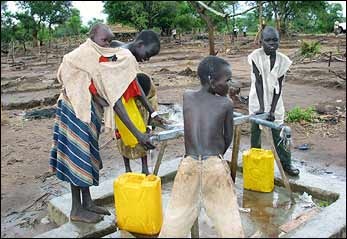
Children pump water in the now-empty transit centre at Madi Okollo, where some 7,000 Sudanese refugees were recently moved.
But he predicts even more money will be needed to reach that point. "By the middle of next year, we should overcome this emergency phase," the minister said. "But after stabilising these people, we will have to build schools, roads will have to be upgraded and we will go into a developmental phase."
For now, though, that seems wishful thinking. The person who will have the difficult job of overseeing the two new settlements is Alice Ballah-Conteh, Head of UNHCR's sub-office in Arua. "Without funds, things are going to be difficult," she warns.
By Kitty McKinsey in Madi Okollo and Ikafe, Uganda


